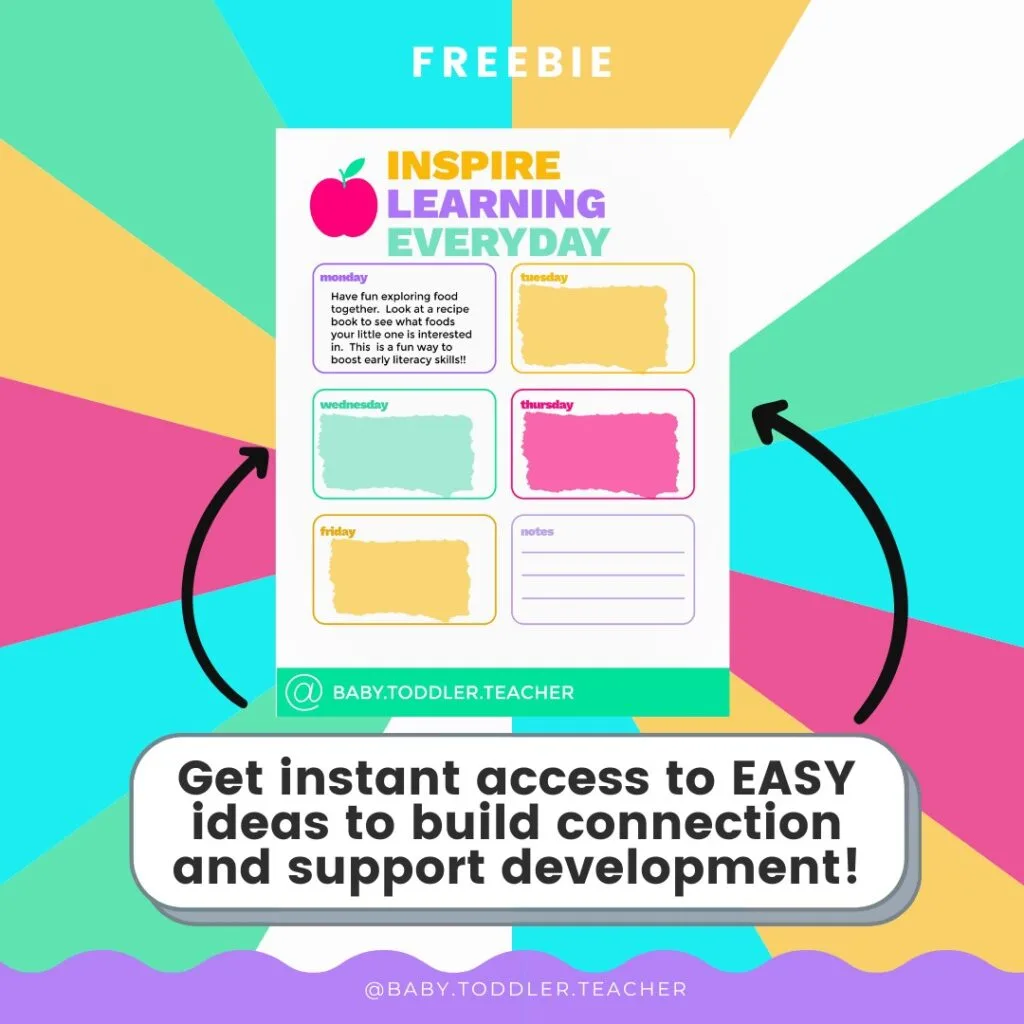One of the biggest challenges that parents of two-year-olds face is how to keep their little ones busy!
At this age, toddlers are full of energy and curiosity and tend to have a short attention span.
Without the right activities to occupy them, they can quickly become bored and restless.
But don’t worry, I have got you covered!
As a Developmental Therapist who works in early intervention and a mom of 2, I think I have some unique ideas to offer your way.
In this blog post, I will share some different ways to keep your two-year-old engaged and happy…most of the time!
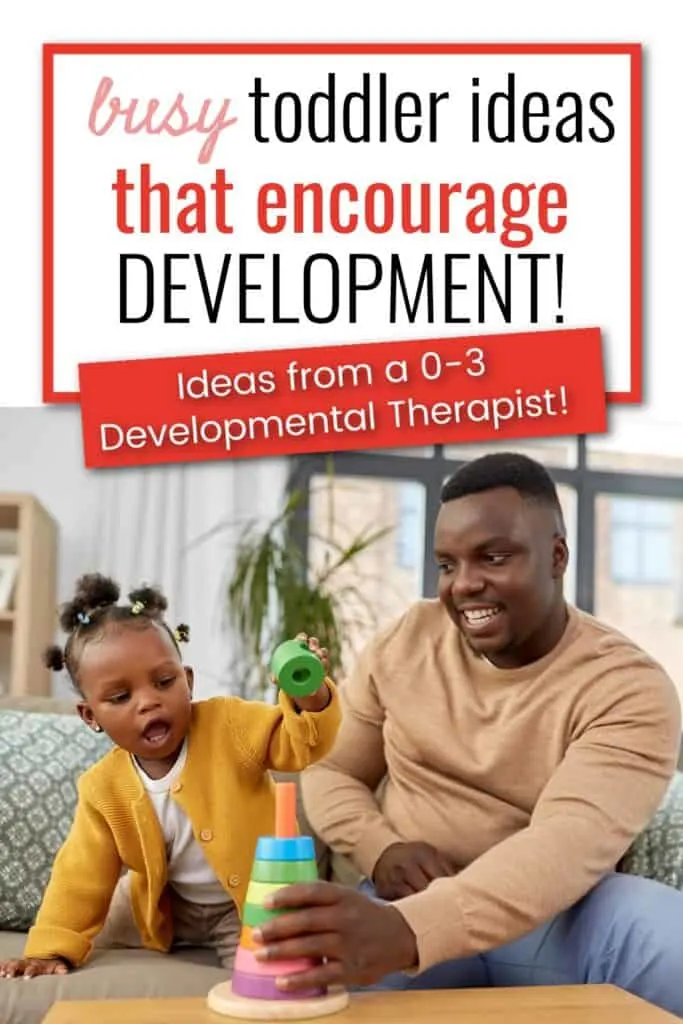
(This post may contain affiliate links. To read our full disclosure policy click here.)
Keep Toddlers Busy by Including Them
I remember when I was staying at home with my toddler, scouring the internet for ideas/activities that would keep my little boy busy.
What I found though is I would spend more time setting up an activity than he would actually spend doing it!
That is when I went back to what I had learned while working in early intervention: One of the best ways for kiddos to learn…is by looking at daily routines and embedding learning there.
Toddlers love to feel involved, and including them in daily activities and chores can be a great way to keep them busy while also teaching them important life skills.
For example, let them help with cooking and baking, setting the table, or folding laundry.
When I started letting my son “help” with these tasks, I was able to get things done during the day and I did not have to spend time setting up activities that would hold his interest for 2 seconds.
Now I will say when you let your toddler help with these sorts of tasks…they will take longer, but you will spend less time searching and setting up activities!
They may make a mess at first, but this is the first step in teaching them to do these things!
Plus, it’s a great way to spend quality time together.
Set Them Up for Independent Playtime
While it’s important to spend time with your child, it’s also important to encourage them to play independently.
This will not only help them develop their creativity and imagination but also give you some much-needed free time.
Now this does not mean unsupervised time…this just means that you take on the role of the observer, instead of being the one that is leading or engaging in play.
Select Open-Ended Toys for Independent Play
Selecting the right toys can make a tremendous difference in your child’s independent play experience.
Try to opt for open-ended toys – these are toys that can be used in multiple ways and foster creativity and exploration.
Examples of open-ended toys include:
Open-ended toys enable children to use their imagination and develop their problem-solving skills.
They are not bound by a specific set of rules or instructions, allowing them to play and explore at their own pace.
While playing with these toys, children learn to think out of the box, improvise, and understand the concept of cause and effect.
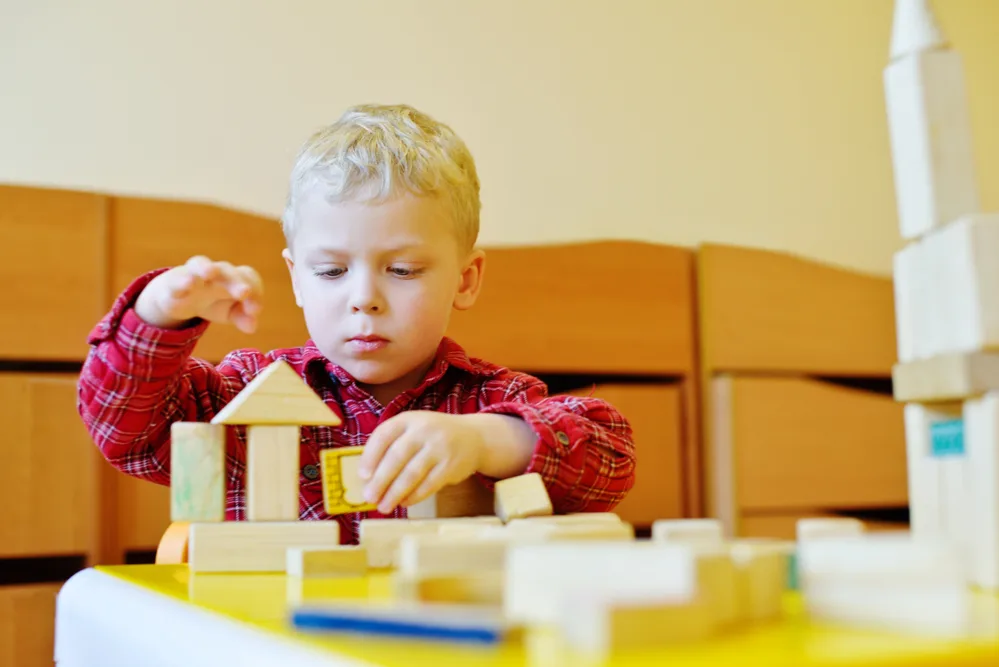
Only Set Out a Few Toys at a Time
While it might be tempting to give your child access to all their toys at once, this can actually be counterproductive.
Too many options can overwhelm a child and reduce the quality of their play.
Instead, try limiting the number of toys you set out at a time.
This can help maintain their interest and focus.
Rotate the available toys every so often to keep things fresh and exciting.
By offering a curated selection of toys, you encourage your child to explore each toy thoroughly, fostering deeper engagement and learning.
Have Engaging Toys to Keep Your Toddler Busy
One of the best ways to keep your two-year-old busy is to provide them with toys that are both fun and educational.
Look for toys that encourage sensory exploration, physical activity, problem-solving, and creativity.
Some great options include building:
Make sure to choose toys that are age-appropriate, safe, and durable.
Building Toys will Hold Your Toddler’s Attention
Building toys, particularly wooden blocks (like these) and Duplos (you can see them here), are an exceptional way to keep your toddler’s attention.
These toys, typically composed of multi-colored blocks of varying shapes and sizes, foster creativity, spatial skills, and problem-solving.
With wooden blocks or Duplos, a toddler can build towers, create make-believe landscapes, or even sort them by color or size.
The tactile nature of these toys appeals to a toddler’s sensory curiosity, while the challenge of stacking and arranging blocks keeps them engaged.
Moreover, these toys have no definitive end-goal, inviting children to revisit the activity multiple times and always offering something new to learn or explore.
The sheer versatility and longevity of building blocks make them an excellent investment in your child’s playtime.
Avoiding screentime? Try this alternative!
Are you worried about using too much screen time?
While it’s tempting to use screens to keep your child occupied, it’s important to limit their screen time and provide them with other forms of entertainment.
You can read about the recommendations for screen time HERE.
One thing I absolutely love is using kid podcasts and audiobooks as a way to get some quiet time without using a screen…and they have many great options now!
Unlike screen time, audiobooks and podcasts stimulate children’s imagination and creativity, encouraging them to create their own visual interpretation of the story.
In addition, audio books offer a practical benefit for busy parents – they can keep children engaged during car rides, or downtime at home, promoting a love for learning and books from an early age.
Here are some of my favorite kid podcasts (sometimes I even enjoy listening to them!):
When it comes to audiobooks I usually just use my local library’s online lending library.
If you are not hooked up with yours, I would go get a library card and see what they have available.
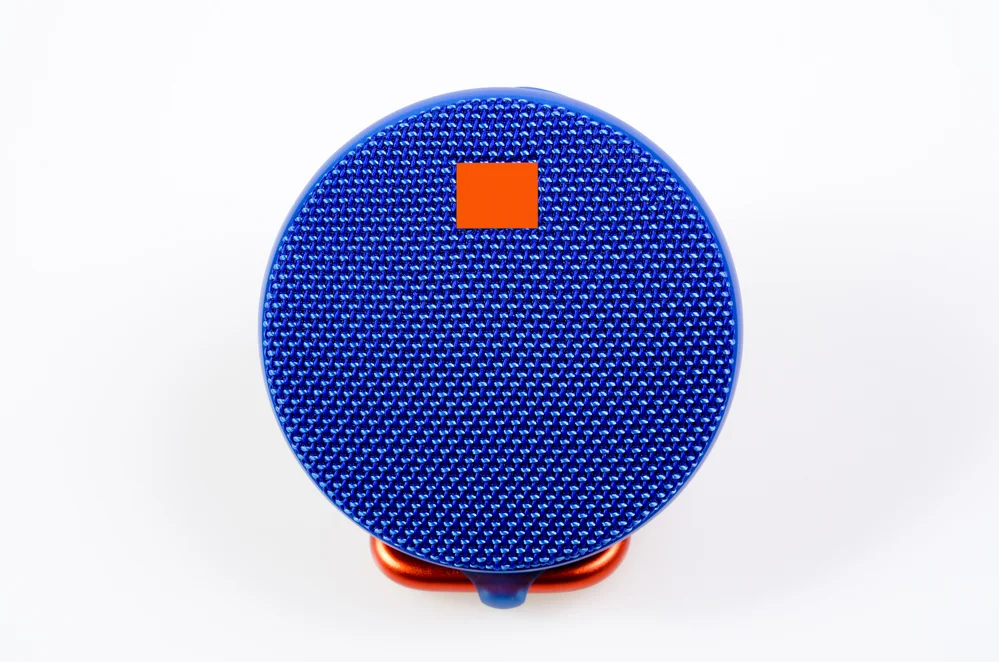
The Best Audio Devices to Keep Your Toddler Entertained
When it comes to keeping your toddler entertained with audio content, there are several fantastic devices on the market that do not require the use of your smartphone.
The Toniebox is a popular choice, with its child-friendly design that allows kids to simply place a figurine on top to start playing an associated story (take a look at it here.)
It’s sturdy, portable, and comes in a range of vibrant colors.
Similarly, the Yoto Player (see it here) provides a card-based interface where kids can insert a story card into the slot to begin listening.
It offers a wide range of content, including stories, music, and podcasts, promoting independent listening and learning.
Storypod is another excellent tool (check it out here) combining traditional storytelling with interactive, 3D characters called “Crafties”.
When children place a Craftie on Storypod, they can listen to stories, songs, and more.
This creative approach not only keeps kids engaged but also stimulates their imagination.
Each of these devices provides a safe, engaging way for children to enjoy audio content independently, encouraging a love for learning and storytelling.
Encourage Fine Motor Skills with Sensory Play
Sensory play can be a fun way to nurture fine motor skills in toddlers.
Offering activities that involve manipulating different materials, such as play doh, sand, or water, can help children develop vital hand-eye coordination and dexterity.
For instance, kneading playdough, sifting sand, or pouring water necessitate the use of small muscle groups in the hands and fingers, reinforcing fine motor control.
These sensory activities not only engage children’s senses but also provide them with countless opportunities to learn, explore, and develop essential skills in a playful, enjoyable manner.
If there was one thing that kept my children occupied and held their attention the longest it was water play.
We would sometimes even just do an extra bath during the day so that they could have some water fun.
If you are feeling overwhelmed by the idea of creating sensory bins know that you can keep it really simple, that is what I always did!
Get Creative with Household Items
A sensory bin can be easily constructed using common household items, offering a cost-effective, and equally engaging, alternative to store-bought toys.
You can utilize a large, shallow container as the base of your sensory bin.
Oftentimes times I would use just a cake pan or even a cookie sheet for a sensory activity!
Fill it with materials like water, rice, dried pasta, or beans for a tactile base.
Items such as measuring cups, plastic cups, wooden spoon, or funnels can become tools for scooping and pouring.
Add in a variety of interesting objects or plastic toys to create an exciting mix that will stimulate your child’s curiosity and investigative skills.
Remember, the key to a successful sensory bin lies in providing a diverse array of textures and shapes, fostering an enriching hands-on exploration platform for your child.
You will always want to supervise your toddler closely when they are doing this type of activity to make sure that they are not putting the items in their mouth.

Grab your FREE Milestone Guide HERE.
Explore Water with an Ice Cube Tray
Remember how I said water play was always a hit with my kids?
Not only do they love water they also love exploring and melting ice!
One of their favorite things to do was freeze a toy or object in a plastic bowl and then watch it melt.
Sometimes they would take it outside to watch it melt or run water over it.
This mini-science activity goes hand in hand with sensory play!
They also loved to paint with ice cubes or water!
Burn Energy and Encourage Gross Motor Skills with an Obstacle Course
Creating a simple obstacle course using pillows and cushions is an effective and fun way to encourage your toddler to burn energy and develop gross motor skills.
Start by choosing an open area in your home and layout cushions and pillows in different configurations.
You can set them up as stepping stones, tunnels, or barriers.
For instance, place pillows in a line for your toddler to jump over or arrange cushions in a zigzag pattern for them to navigate.
You might also stack pillows to create mini mountains for climbing.
Encourage your child to run, jump, crawl, or roll over these soft obstacles, promoting their physical strength, balance, coordination, and agility.
Remember to ensure the course is safe, eliminating any sharp objects or tripping hazards in the vicinity.
With your supervision, this indoor activity can provide hours of entertainment for your toddler while helping them refine their gross motor abilities.

Encourage Creative Thinking with Cardboard Boxes
Empty cardboard boxes can be a wellspring of creativity and amusement for your toddler.
With a bit of imagination, these boxes can transform into fantastical forts, castles, or even spaceships.
Encourage your child to crawl inside and imagine they’re journeying to distant worlds.
Even more, you can provide markers, crayons or stickers, and let your child decorate the box both inside and outside, sparking their artistic prowess.
Such activities not only entertain and engage your toddler but also stimulate their creativity, spatial understanding, and fine motor skills.
Always remember to supervise these playtimes for safety.
Easy Activities with Painters Tape
Painter tape is a versatile tool that can be used to create a multitude of engaging activities for your toddler.
For instance, you could use it to design a simple maze or track on your floor or carpet, turning your living room into a playground where your child can race toy cars or navigate their way through (always test it on any space that you are using it on to make sure it doesn’t cause any damage.)
Alternatively, create a hopscotch grid, encouraging your toddler to jump from square to square, thereby improving their balance and coordination.
Remember, like with all toddler activities, supervision is essential to ensure safety.
One of the best things about using painter’s tape is that it is easily removable, leaving no sticky residue behind.
Pretend Play is So Much Fun for Little Kids
Pretend play is an absolute hit among little kids, opening up a world of imagination and creativity.
It offers endless opportunities to explore different scenarios, roles, and environments.
For instance, playing ‘house’ allows children to mimic daily routines and roles they observe, while pretending to be ‘doctors’ or ‘teachers’ can help them understand different professions.
Playing ‘superheroes’ can evoke courage and resilience, and ‘playing shop’ teaches them about money, calculation, and negotiation skills.
Engaging in ‘adventures’ like treasure hunts or space exploration unleashes creativity and problem-solving abilities.
A favorite of my kids is to take their stuffed animals and play either zoo, pet store, or vet.
Remember to provide props that align with their chosen play theme, like costume pieces, toys, or everyday household items.
These can aid in making their imaginative play seem more real, fueling their engagement and learning.
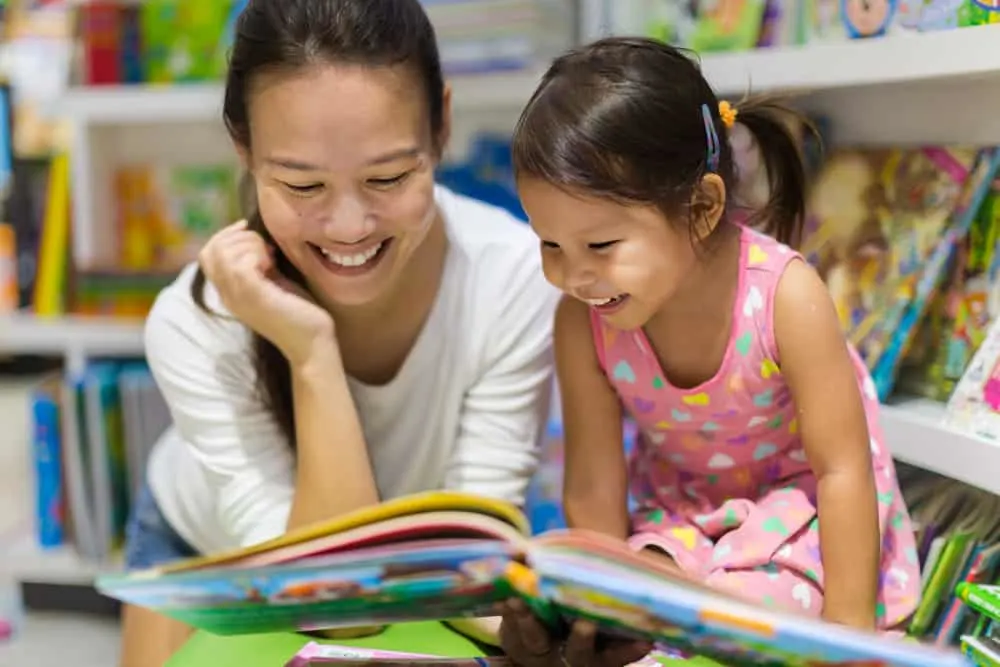
Take Time to Look at Picture Books
Looking at picture books with your toddler is an excellent activity that provides numerous educational benefits while nurturing a lifelong love for reading.
Picture books (these are some of my favorites) draw children in with their vibrant illustrations and simple text, making reading a visually exciting adventure.
As you read out loud, your toddler will begin to associate the spoken words with their corresponding images, enhancing their vocabulary and comprehension.
Moreover, this shared activity fosters a stronger parent-child bond, as you together navigate the stories, discuss the pictures, and indulge in shared laughter or suspense.
It’s an immersive way to stimulate your toddler’s imagination, cognitive abilities, and language development, all while spending quality time together.
You can also have some independent time with books as well.
Set up a comfortable corner in your home and offer some age-appropriate books for your toddler to explore.
Let them examine the pictures and narrate the stories from their own perspective, allowing them to further build confidence in their language skills.
As they advance, you can start introducing books with more words, encouraging reading for entertainment and education.
Have Fun with Toddler Games
Engaging your toddler in games can bring loads of fun while simultaneously promoting crucial development skills.
Matching games, for instance, are excellent tools for improving memory, concentration, and cognitive abilities.
By identifying similarities and differences, toddlers learn about patterns, shapes, and colors, enhancing their observational skills.
On the other hand, scavenger hunts awaken the natural explorer in your toddler.
As they embark on mini adventures around the house or outdoors, they improve their problem-solving skills, fine-tune their motor skills, and become more aware of their surroundings.
Infusing learning with play, these games offer a dynamic, interactive platform to foster growth and development in a joyful, stress-free way.
Quiet Play with Activity Books
Alternating between activities where your child gets to move around and activities that are a little quieter can be a great thing because it allows you to break up the day.
Activity books are a great way to do this, as they can provide calm and focused playtime that encourages learning.
My kids absolutely loved these sticker books for exploring different topics such as bugs and dinosaurs.
Books that include reusable stickers (like this) can be a lot of fun as your child gets to use their imagination as they create a scene on a background.
Classic coloring books can be a hit as well!
We also love these giant ones that you can color on the floor with.
Puzzle Play is Great for Problem Solving
Easy Puzzles (like these) offer an engaging platform for toddlers to hone their problem-solving skills.
When a child attempt to fit different pieces together to form a complete picture, they are essentially learning to identify patterns, analyze shapes, and exercise spatial awareness.
This process requires critical thinking and perseverance, with every unsuccessful attempt propelling them to try different tactics until they achieve a successful outcome.
Puzzles, therefore, not only stimulate cognitive development but also instill a robust sense of determination and resilience, integral to problem-solving in real-world scenarios.
There are so many puzzles to choose from so start with simple ones and switch to more complex ones as your child’s skills and interests develop.
You can even create your own puzzle by cutting up the front of a cereal box and having your toddler piece it together!
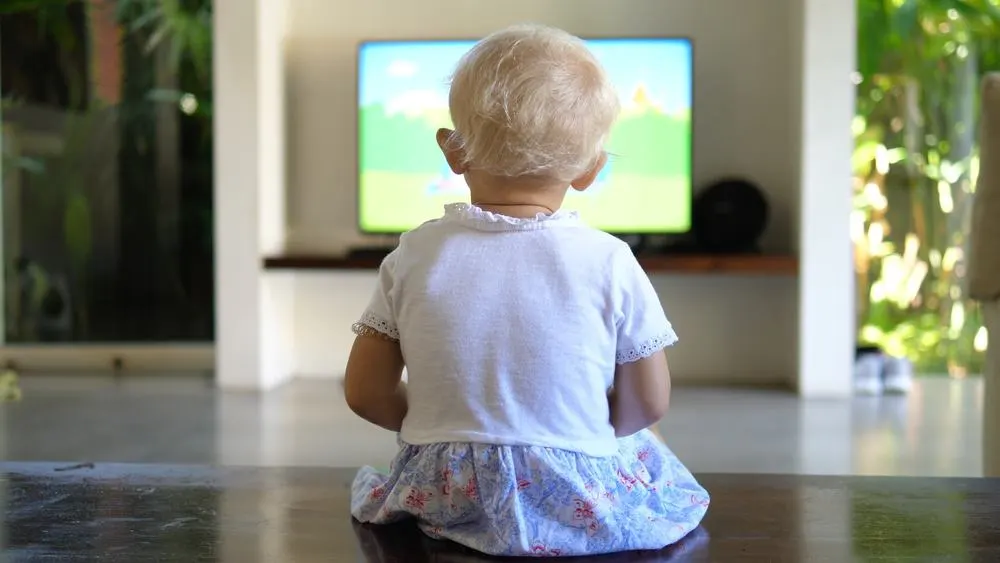
Using Screen Time to Keep Toddlers Busy
There are times when turning on the TV feels like the only way that you can get a break or to get that one thing crossed off your to-do list…and that is ok!
My children both used screens in their toddler years and there were actually some things they learned from shows that I would have never thought to teach them!
If you do decide to use screens, make sure to choose programs that are age-appropriate, educational, and interactive.
Look for programs that encourage your toddler to learn new skills, engage with the content, and get up and move around.
Some of my favorite shows out there include:
Avoid programs that are passive or overly stimulating, as these can be overwhelming for young children.
Hope these fun ideas keep your toddler busy!
Keeping a two-year-old busy can be a challenge, but with the right strategies and tools, it’s definitely doable.
Encouraging your child to participate in daily activities, setting them up for independent play, providing engaging toys, trying screen-free alternatives, and choosing the right programs for screen time are all great ways to keep your toddler happy and entertained.
Remember, every child is unique, so experiment with different activities and approaches to find what works best for your little one.
Good luck, and have fun!
Related Posts You will Enjoy
The Best Non-Toy Gifts for Toddlers
Easy Social-Emotional Activities for Toddlers
Do time-outs work? What you can try instead!
Fun Toddler Magazine Subscriptions that Make Great Gifts
Frequently Asked Questions about How to Keep Toddlers Busy
No. While it is important to provide your toddler with regular attention and activities, you do not need to constantly entertain them. Toddlers are capable of entertaining themselves for short periods of time as long as they have the right toys and environment.
This varies from child to child. Generally, it is best to start by setting small goals and gradually increasing the amount of time your toddler plays independently. You will still need to supervise your toddler even when they are playing on their own.
Common Sense Media recommends no more than one hour of quality screen time per day for children ages 2-5. As a parent, I have always tried to follow their recommendations the best to my ability but as you know life happens and there were some days my children had more than the recommended screentime.
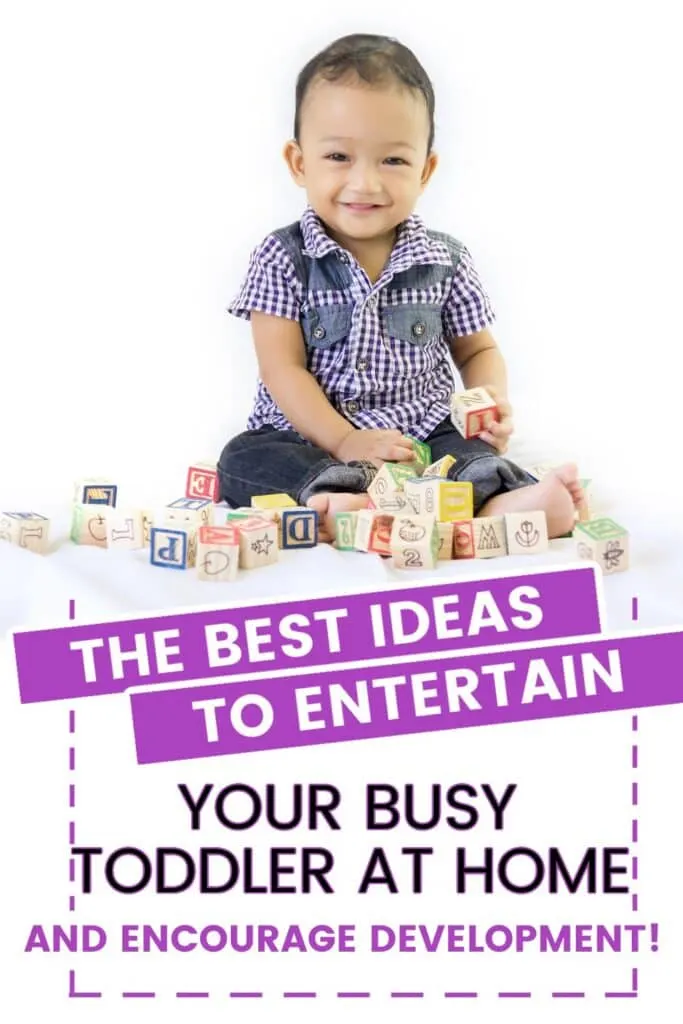

Kayla O’Neill has a master’s degree in education as well as a bachelor’s degree in special education with an emphasis in early childhood education. She has been working as a developmental therapist with babies and toddlers in early intervention since 2012. She is also a mom with two young children.
